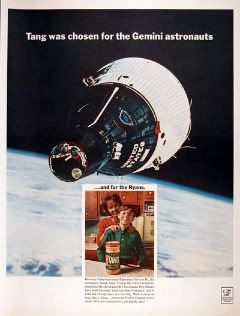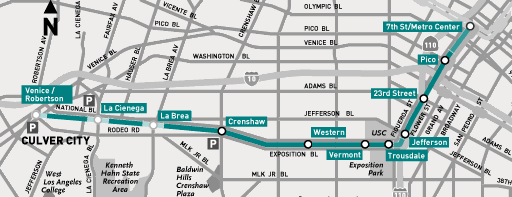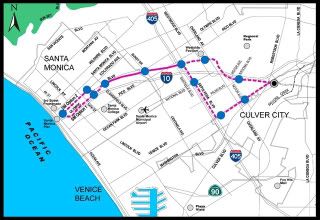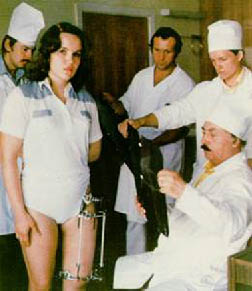All Aboard

MTA may have to cut commuter service
It may not be able to keep trains and buses running if it has to quickly pay investors in AIG-related lease-back deals.
The agency recently lost $133 million in state funds, and declining sales tax revenues mean it will have less money to help keep its buses and trains rolling.
Between the late 1980s and 2003, the MTA sold its rail equipment, more than 1,000 buses, a parking garage and maintenance facilities to investors that included Wells Fargo, Comerica and Phillip Morris in separate deals.
Lease-back deals are a common way to raise money in the corporate world. A manufacturer, for example, could sell its factory to investors and then lease it back. The manufacturer gets a large chunk of cash and the investors get a steady stream of lease payments as well as a tax break for their depreciating property.
Metrolink, the Southland's commuter rail agency, also sold most of its train cars and locomotives in four lease-back deals -- three of which involved AIG -- and made a $35.5-million profit as a result, said spokesman Francisco Oaxaca.
The lower credit ratings triggered a clause in the lease-back agreements that require the MTA to either find a new firm to guarantee the deals or reimburse investors for their down payments and lost tax benefits, a scenario that could cost the transit agency between $100 million and $300 million.
Under a worst-case scenario, Matsumoto said, the bill could rise to $1.8 billion, more than half the MTA's annual budget for this year. "There is no practical way we could ever pay that back," he said.
Both Matsumoto and LaRusch said the Federal Transit Administration encouraged transit agencies to make lease-back deals as a way to make money. The MTA said it made about $65 million on the deals.
But an FTA spokesman disagreed.
"FTA was not a cheerleader for these transit lease-back agreements," agency spokesman Dave Longo wrote in an e-mail. "We reviewed lease-back agreements submitted to us by transit agencies in terms of their compliance with federal transit law requirements. When we determined those agreements met the requirements, we approved them from that perspective."
So, we don't even own our own trains and buses in LA!?
We sold the trains to the Marlboro Man!? At the same time the county is trying to combat smoking it does business with a tobacco giant.

**In addition to the Marlboro brand Phillip Morris, also such owns such delicious brands as Capri Sun, Kool-Aid, Tang, Jell-O, Nutter Butters, Cheeze Whiz, Oscar Meyer and Grey Poupon.
Smoking cessation in Los Angeles County
The vision of the L.A. County Tobacco Control and Prevention Program (TCPP) is a smoke-free Los Angeles county. In over 15 years since the County of Los Angeles Department of Public Health's Tobacco Control and Prevention Program was first funded by the California Department of Public Health's /Tobacco Control Program through Proposition 99, the California Tobacco Tax Initiative, many advances in the fight against tobacco have been made in Los Angeles County. The mission of TCPP is to reduce tobacco-related death, disease, and disability in Los Angeles County. To this end TCPP works closely with community-based organizations and coalitions, health advocates and other health providers to provide tobacco prevention, education, policy, cessation, and media services throughout the County of Los Angeles. The goals of TCPP are: 1) to decrease secondhand smoke, 2) to reduce tobacco availability, 3) to counter pro-tobacco influences and 4) to provide tobacco cessation. TCPP does this by using a comprehensive "social norm" change model.
*It reminds me of the, Children and Families Act of 1998, which, ". . . put a fifty-cent tax on cigarettes, generating more than $700 million annually. Local boards have discretion over how to spend the funds for children ages zero to five, but several counties are using the funds for universal access to prekindergarten. For example, Los Angeles County committed $100 million a year for ten years to jump-start the move to universal prekindergarten." -Prekindergarten Policy Framework
So, at the same time that the County is attempting to combat smoking it now depends on cigarette tax revenue to fund it's universal prekindergarten program. There is a clear conflict of interest. I don't deny that prekindergarten programs are necessary but why should the smokers of California bare the financial burden for providing prekindergarten?
But don't smokers cost the County millions in health care? Yes, undoubtedly.
Then shouldn't the county and state be able to tax tobacco to offset those cost? Yes, totally and they tried to with the 2006 California Tobacco Tax Initiative, which failed to pass but the Children and Families Act, provides no money to alleviate the increased health care costs that smokers create.
Whoa, reel it in, get back to the buses and trains.
I'm sure the MTA was strapped for cash but lease-back agreements seem as screwy as credit default swaps.
I'm not exactly Louis Rukeyser, but how does the MTA owe between $100 to $300 million and potentially $1.8 billion from a deal that netted only $65 million?
So, at the same time the city is trying to encourage mass transit use in an effort to reduce congestion and improve environmental quality, service may be cut.
Ridin' that Train
In other transit news according to the Build Expo website , phase 1 of the The Exposition Light Rail Transit Line (Expo Line), which will run from downtown Los Angeles to Culver City, is still on schedule to open in the summer of 2010. Phase 2 of the project, which will run from Culver City to the beach is currently undergoing environmental review. The Exposition Construction Authority, hopes to begin the construction of phase 2 in 2010, with service beginning in 2014 or 2015. Two routes are being considered for phase 2, one would travel down the median of Olympic Blvd while the other would travel down the middle of Colorado Blvd. The Authority also needs to determine where the maintenance facility necessary to service the Expo line will be located. It's a shame that Bergamot Station has been put to other uses.
Bergamot Station is the historical name for the site on which the gallery complex is located, dating back to 1875 when it was a stop for the Red Line trolley running from Los Angeles to the Santa Monica Pier. Bergamot is a flower of the mint family that once flourished in the area.
When the trolley cars stopped running in 1953, the site's warehouse buildings housed a celery packing operation, then an ice-making plant, and finally a factory for the manufacture of water heaters. Thereafter, the City of Santa Monica purchased the property which then sat abandoned, with plans for it to once again serve as an eventual transit stop, this time for a proposed light rail line running from Los Angeles to Santa Monica.
Plans for the light rail were eventually shelved and the City, seeking an interesting use for the site, approached Wayne Blank, developer and co-owner of the Shoshana Wayne Gallery. Blank's development expertise has already been tapped by the City of Santa Monica for an earlier project: the conversion of a vacant city-owned airport hangar into artists' studios. The City, pleased with the project's outcome, asked Blank to conceive of an artistic use for the Bergamot Station site. Bergamot Station, a campus-like complex that has retained its industrial and rustic look, held its official opening on September 17, 1994.

Phase 1 of the Expo Line
The terminus of phase 1 at Venice & Robertson is going to be an aerial station. Unfortunately, the Expo site doesn't have any more information or a picture detailing what the aerial station will look like.

Phase 2 of the Expo Line
Labels: Culver City


0 Comments:
Post a Comment
<< Home